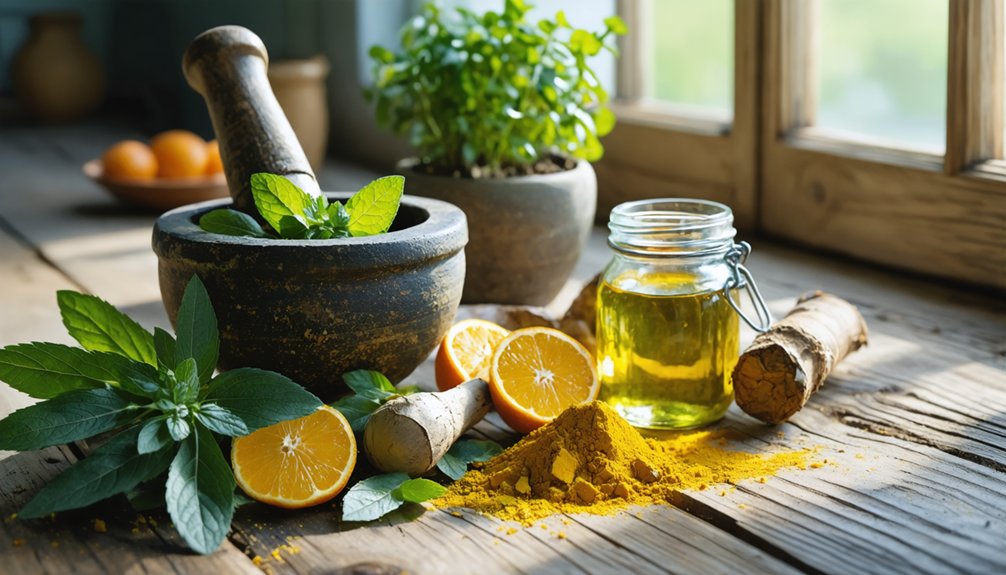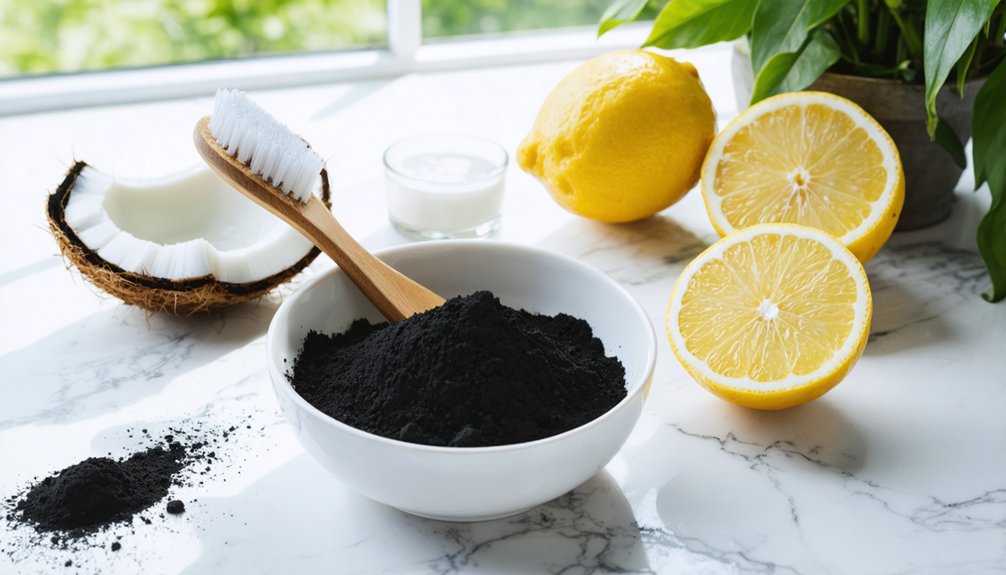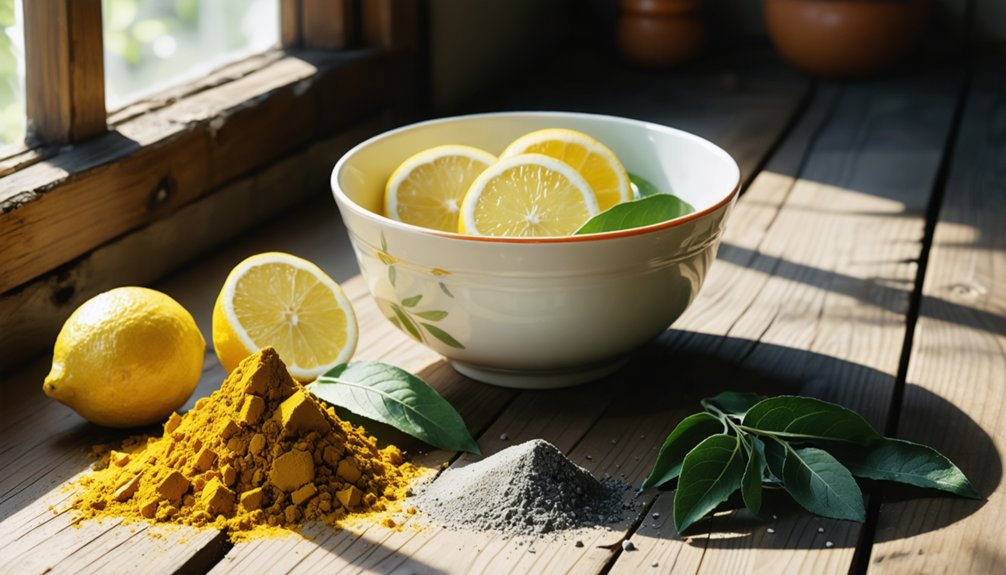You can brighten yellow teeth naturally using several proven home remedies. Mix baking soda with hydrogen peroxide to create a whitening paste, or try oil pulling with coconut oil for 15-20 minutes daily. Consume crunchy fruits and vegetables like strawberries and carrots, which naturally scrub teeth while providing beneficial enzymes. Maintain proper brushing techniques with fluoride toothpaste, and consider herbal remedies like turmeric paste for enhanced results. These natural solutions offer effective alternatives to expensive treatments.
Key Takeaways
- Mix baking soda with hydrogen peroxide to create a gentle whitening paste, applying twice weekly for safe removal of surface stains.
- Incorporate crunchy fruits and vegetables like strawberries, pineapples, and carrots into your diet for natural teeth whitening effects.
- Practice oil pulling with coconut or sesame oil for 15-20 minutes daily to help reduce stains and promote oral health.
- Create natural whitening pastes using turmeric and coconut oil, or neem and sage, to combat discoloration and reduce plaque.
- Use a straw when drinking staining beverages, and wait 30 minutes after acidic foods before brushing to protect enamel.
Understanding the Causes of Yellow Teeth
Yellow teeth, a common cosmetic concern, stem from various internal and external factors that affect tooth coloration over time.
Your daily consumption habits, including dark-colored foods, beverages like coffee and wine, and acidic substances, can gradually stain your tooth enamel. Lifestyle choices such as tobacco use and poor oral hygiene greatly contribute to discoloration. Daily flossing and brushing can help prevent most surface stains from becoming permanent.
Medical factors also play an essential role in tooth yellowing. Certain medications, particularly tetracycline antibiotics taken during tooth development, can cause permanent staining. Regular dental visits are crucial as skipping checkups allows stains to accumulate and become more difficult to remove.
Genetic factors influence your natural tooth color and enamel thickness, affecting how susceptible your teeth are to discoloration. Environmental elements like excessive fluoride exposure and metal contact can further impact tooth color, while aging naturally reveals the yellowish dentin beneath thinning enamel.
The Power of Baking Soda and Hydrogen Peroxide
To safely mix your baking soda and hydrogen peroxide solution, combine two parts baking soda with one part 3.5% hydrogen peroxide until you achieve a paste-like consistency.
You’ll want to brush with this mixture gently for two minutes, being careful not to apply excessive pressure that could damage your enamel.
Using ARM & HAMMER™ Baking Soda ensures the safest and most reliable whitening results with this method.
While this mixture can help remove surface stains, it cannot change your teeth’s natural color or whiten deep stains.
For best results and safety, limit your treatments to twice per week, and discontinue use if you experience any tooth sensitivity or gum irritation.
Safe Mixing Instructions
The safe combination of baking soda and hydrogen peroxide requires precise measurements to create an effective teeth-whitening paste without risking dental damage.
To achieve ideal mixing ratios, combine 2 parts baking soda with 1 part 3% hydrogen peroxide – never use concentrations higher than 3% for home use.
Once you’ve created your paste, proper application techniques are essential for safety.
Apply the mixture gently using a soft-bristled toothbrush in circular motions, keeping contact time to 1-2 minutes maximum. Watch for any signs of sensitivity or gum irritation and discontinue use if discomfort occurs.
Regular use of this mixture can cause permanent enamel damage if not properly managed.
You’ll want to limit usage to once per day, no more than twice weekly.
After application, rinse thoroughly with water and follow up with regular fluoride toothpaste.
Always prepare fresh paste before each use to maintain effectiveness and prevent contamination.
Weekly Treatment Schedule
Following proper mixing techniques, a structured weekly treatment schedule maximizes the whitening potential of baking soda and hydrogen peroxide while protecting your dental health.
You’ll want to limit weekly application to 1-2 treatments, applying the mixture for just one minute before thoroughly rinsing. This treatment frequency provides ideal results while minimizing risks of enamel damage or sensitivity. Creating a paste with equal parts of each ingredient ensures safe and effective application.
Between treatments, maintain regular oral hygiene and avoid immediate whitening sessions if you experience any discomfort. If you have exposed roots or gum recession, skip treating those areas entirely. Higher-concentration treatments used by dental professionals can achieve faster results but should only be administered in a clinical setting.
Remember to never swallow the mixture during application, and always rinse completely afterward. This careful approach helps you achieve brighter teeth safely while preserving your enamel’s integrity and preventing tissue irritation.
Traditional Oil Pulling Methods
If you’re interested in trying oil pulling, an ancient Ayurvedic practice for oral health, you’ll want to select from proven options like sesame, coconut, or sunflower oil.
You’ll need to swish your chosen oil around your mouth for 15-20 minutes before spitting it out, though scientific evidence supporting its teeth-whitening benefits remains limited.
To avoid potential health risks, always spit into trash rather than your sink or toilet. While traditional practitioners claim this method helps reduce plaque and bacteria, it’s important to maintain your regular dental hygiene routine alongside any oil pulling practice. The American Dental Association does not currently recommend oil pulling due to insufficient research support.
Ancient Oral Health Practice
Originating over 3,000 years ago in ancient India, oil pulling represents a cornerstone of Ayurvedic medicine that’s maintained its relevance in modern oral healthcare practices.
This ancient ritual involves swishing a tablespoon of edible oil in your mouth for 15-20 minutes, typically performed on an empty stomach each morning.
As you pull the oil between your teeth and around your gums, it gradually becomes milky white and thinner, indicating the extraction of bacteria and toxins.
The holistic benefits extend beyond oral hygiene, as traditional practitioners believe it can address various systemic conditions.
While scientific evidence remains limited, studies suggest oil pulling may reduce bacterial count and inflammation when used alongside regular brushing and flossing, making it a valuable complement to your daily oral care routine.
Types of Pulling Oils
Traditional oil pulling practitioners employ a diverse range of oils, each offering unique therapeutic benefits for oral health.
While coconut oil stands out for its lauric acid content and antimicrobial properties, sesame oil delivers potent antioxidants and vitamin E.
You’ll find sunflower oil provides a neutral-tasting option rich in nutrients that combat oxidative stress.
For enhanced effectiveness, you can explore oil combinations like adding a few drops of peppermint or tea tree oil to your preferred carrier oil.
These essential oils boost antimicrobial activity while improving taste.
If you’re seeking specialized oil properties, consider neem oil for its strong antibacterial effects or avocado oil for its anti-inflammatory benefits.
When selecting your pulling oil, prioritize those with clinical evidence supporting their efficacy, particularly coconut and sesame oils.
Best Pulling Techniques
Mastering proper oil pulling technique requires attention to specific motions and timing for best results.
You’ll want to start with one tablespoon of oil, allowing solid oils like coconut oil to melt completely in your mouth before beginning. Execute gentle pulling motions, pushing and pulling the oil between your teeth to reach interdental spaces where bacteria hide.
Practice breathing through your nose while swishing for 5-20 minutes, gradually building duration as you become comfortable. Watch for changes in oil consistency – it should become thinner and milky as it mixes with saliva.
When finished, spit the oil slowly into a trash can, never down the drain. Rinse thoroughly with warm water or saltwater, then brush your teeth to remove any remaining debris and complete your oral care routine.
Smart Dietary Choices for Whiter Teeth

While many people turn to expensive whitening treatments, making strategic dietary choices can naturally enhance your teeth’s appearance and maintain their whiteness over time. Incorporating specific fruits and vegetables into your daily meals can greatly impact your oral health and tooth color.
A healthy diet rich in strategic food choices offers a natural, cost-effective alternative to pricey tooth-whitening treatments.
- Consume fruits rich in natural whitening compounds – strawberries contain malic acid that removes surface stains, while pineapples offer bromelain that breaks down plaque.
- Add crunchy vegetables like carrots and celery to naturally scrub teeth during chewing, while broccoli’s high iron content helps prevent staining.
- Include dairy products, especially aged cheeses, as their calcium and casein content strengthens enamel while protecting against discoloration.
Remember to stay hydrated throughout the day, as water helps neutralize acids and maintain ideal oral health through increased saliva production.
Essential Brushing Techniques and Tools
Proper brushing techniques and the right tools form the foundation of any successful teeth-whitening regimen.
You’ll need to brush at least twice daily for two minutes using a soft-bristled toothbrush and fluoride toothpaste. Apply gentle circular or back-and-forth motions to effectively remove surface stains without damaging your enamel.
For enhanced whitening results, consider using specialized tools like whitening toothpaste containing silica or baking soda. An electric toothbrush, such as the Oral B Pro, can provide more consistent cleaning action.
You can also create a natural whitening paste by mixing baking soda with water, though use this sparingly. After any whitening treatment, wait before brushing and use gentle strokes to protect your teeth’s newly brightened surface.
Healing Herbs for Natural Teeth Whitening

Several powerful herbs offer natural alternatives for teeth whitening while promoting overall oral health.
Nature’s medicine cabinet provides gentle yet effective solutions for achieving a brighter smile while nurturing complete oral wellness.
You’ll find that turmeric benefits include reducing inflammation and plaque buildup, while neem properties naturally combat discoloration.
Sage uses extend to minimizing tartar formation, and oregano effects include potent antimicrobial action against decay-causing bacteria.
- Mix turmeric with coconut oil to create a gentle whitening paste that fights inflammation while brightening your smile.
- Apply clove oil directly to your gums to maintain their health while reducing surface stains.
- Combine neem and sage in a natural paste to effectively reduce plaque buildup and promote teeth whitening.
These herbal remedies work synergistically to enhance your oral health while naturally improving your smile’s appearance through their combined therapeutic properties.
Nature’s Toothbrushes: Crunchy Foods That Help
Natural teeth cleaning extends beyond traditional brushing, as crunchy foods provide mechanical cleansing effects that help combat yellowing. When you choose crunchy snacks like apples, carrots, and celery, you’re utilizing nature’s toothbrushes to scrub away surface stains and stimulate saliva production.
These foods work through two primary mechanisms: mechanical cleaning and enhanced saliva flow. The abrasive textures of nuts, seeds, and fibrous vegetables act as gentle scrubbers while increasing saliva production, which provides natural enamel protection.
Additionally, many of these foods contain beneficial compounds – strawberries offer malic acid for whitening, while dairy products supply calcium and phosphorus for strengthening teeth. For best results, incorporate these crunchy foods into your daily diet to maintain whiter teeth naturally.
Daily Habits to Maintain a Brighter Smile

Beyond incorporating natural cleansing foods, maintaining a bright smile requires consistent daily practices that protect and enhance tooth whiteness. Your daily oral care routine should focus on prevention and protection, combining proven techniques for ideal results.
- Start with thorough brushing twice daily using fluoride toothpaste, followed by daily flossing to remove debris between teeth where stains often develop.
- Incorporate an antitartar or whitening mouthwash into your routine – the benefits include preventing buildup while maintaining brightness.
- Wait at least 30 minutes after consuming acidic foods before brushing, and use a straw when drinking staining beverages like coffee or wine.
Maintain these practices consistently while staying hydrated throughout the day to support natural saliva production, which helps neutralize harmful acids and preserve your smile’s brightness.
Frequently Asked Questions
Can Yellow Teeth Become Permanently Stained if Left Untreated for Too Long?
Yes, if you don’t maintain proper dental hygiene, your yellow teeth can develop permanent staining as discoloration penetrates deeper into tooth layers, becoming resistant to whitening treatments.
How Long Does It Take to See Results From Natural Teeth Whitening Methods?
Time flies when whitening teeth naturally! You’ll typically see initial results within a few days, but the complete teeth whitening timeline spans 1-4 weeks depending on natural remedy effectiveness and stain type.
Are Natural Whitening Methods Safe During Pregnancy and Breastfeeding?
You’ll want to avoid most natural whitening methods during pregnancy and breastfeeding due to safety concerns. Consult your healthcare provider, as hormonal changes can increase tooth sensitivity and risks.
Can Medications Affect the Effectiveness of Natural Teeth Whitening Treatments?
Yes, your medications can greatly reduce whitening efficacy, especially antibiotics and antipsychotics that cause deep stains. These medication interactions often make natural whitening treatments less effective at removing discoloration.
Should Sensitive Teeth Avoid Natural Whitening Treatments Altogether?
With 65% of sensitive teeth patients reporting discomfort from whitening, you’ll want to avoid natural treatments. Instead, consult your dentist about professional whitening alternatives specifically designed for sensitivity.
References
- https://www.palmsdentalcare.com/how-to-remove-yellow-stains-from-teeth-naturally/
- https://www.medicalnewstoday.com/articles/322421
- https://www.healthline.com/health/dental-and-oral-health/how-to-get-rid-of-yellow-teeth
- https://www.beaversdentistry.com/blog/top-5-dentist-approved-ways-to-fix-naturally-yellow-teeth/
- https://www.pleasantfamilydentistry.com/blog/6-natural-ways-to-whiten-your-teeth
- https://www.mymagnoliafamilydental.com/top-ten-natural-herbs-for-teeth-whitening/
- https://www.armandhammer.com/en/articles/how-to-whiten-teeth-with-baking-soda
- https://www.luriedental.com/dental-services/cosmetic/blog/do-natural-teeth-whitening-remedies-really-work
- https://www.colgate.com/en-my/oral-health/teeth-whitening/the-best-home-remedy-for-teeth-whitening-that-works
- https://www.listerine.co.uk/teeth-whitening/yellow-teeth-causes



